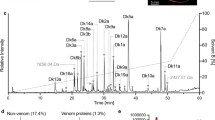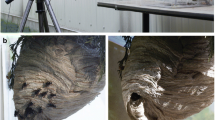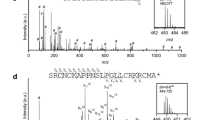Abstract
The major volatile spiroacetals from the venom of both the common wasp, Vespula vulgaris and the German wasp V. germanica, viz. 7-methyl-1,6-dioxaspiro[4,5]decane and 7-ethyl-2-methyl-1,6-dioxaspiro-[4,5]decane, respectively, were synthesized by known methods. These acetals, along with N-isopentylacetamide (the major volatile amide from wasp venom), 2-heptanone (a honeybee pheromone), 2-methyl-3-buten-2-ol (a component of hornet venom), cuticle wax from V. vulgaris, and venom sacs from both wasp species were assayed by EAG and olfactory bioassay for attractancy to V. vulgaris workers. Antennal responses to all test chemicals were recorded. Acetal isomers (±)-2 and (±)-3, N-isopentylacetamide, and 2-heptanone were attractive to V. vulgaris workers at levels of <1 μmol. Greater quantities of the same compounds were repellent to V. vulgaris workers.
Similar content being viewed by others
REFERENCES
ATLAS, R. M. 1993. Pages 55, 375, in L. C. Parks (ed.). Handbook of Microbiological Media. CRC Press, Boca Raton, Florida.
BARZ, W., ADAMEK, C. H., and BERLIN, J. 1970. The degradation of formononetin and daidzein in Cicer arietinum and Phaseolus aureus L. Naturforschung 1735–1744.
BLUM U., and SHAFER, S. R. 1988. Microbial populations and phenolic acids in soil. Soil Biol. & Biochem. 20:793–800.
BOWEN, G. D., and SMITH, S. E. 1981. The effects of mycorrhizas on nitrogen uptake by plants. Ecol. Bull. 33:237–247.
DALTON, B. R. 1989. Physicochemical processes affecting the recovery of exogenously applied ferulic acid from tropical forest soils. Plant Soil 115:13–22.
GILDERSLEEVE, R. R., SMITH, G. R., PEMBERTON, I. J., and GILBERT, C. L. 1991. Detection of isoflavones in seedling subterranean clover. Crop Sci. 31:889–892.
HOAGLAND, D. R., and ARNON, D. I. 1950. The water-culture method of growing plants without soil. California Agricultural Experiment Station Circular 347.
INDERJIT, and DAKSHINI, K. M. 1992. Formononetin 7-O-glucoside (ononin), an additional growth inhibitor in soils associated with the weed Pluchea lanceolata (DC) C. B. Clarke (Asteraceae). J. Chem. Ecol. 18:713–718.
JAQUES, U., KOSTER, J., and BARZ, W. 1985. Differential turnover of isoflavone 7-O-glucoside-6″-O-malonates in Cicer arietinum roots. Phytochemistry 24:949–951.
LEON-BARRIOS, M., DAKORA, F. D., JOSEPH, C. M., and PHILLIPS D. A. 1993. Isolation of Rhizobium meliloti nod gene inducers from alfalfa rhizosphere soil. Appl. Environ. Microbiol. 59:636–639.
LOPES, A. S., and WOLLUM, A. G. 1976. Comparative effects of methyl bromide propylene oxide and autoclave sterilization on specific soil characteristics. Turrialba 26:351–355.
NAIR, M. G., SAFIR, G. R., and SIQUEIRA, J. O. 1991. Isolation and identification of vesicular-arbuscular mycorrhiza-stimulatory compounds from clover (Trifolium repens) roots. Appl. Environ. Microbiol. 57:434–439.
OZAN, A. 1994. Impact of the isoflavone formononetin on the formation of Trifolium-Glomus mycorrhizal symbiosis. Ph.D. dissertation. Department of Microbiology, Michigan State University, East Lansing, Michigan.
OZAN, A., SAFIR, G. R., and NAIR, M. G. 1996. Isozyme activity of developing Trifolium-Glomus mycorrhiza and associated effects of the isoflavones formononetin. Allelopathy J. 3:217–228.
PATRICK, Z. A. 1971. Phytotoxic substances associated with the decomposition in soil of plant residues. Soil Sci. 111:13–18.
SANDERS, F. E. T., and TINKER, P. B. H. 1973. Phosphate flow into mycorrhizal roots. Pestic. Sci. 4:385–395.
SIQUEIRA, J. O., SAFIR, G. R., and NAIR, M. G. 1991a. Stimulation of vesicular-arbuscular mycorrhiza formation and growth of white clover by flavonoid compounds. New Phytol. 118:87–93.
SIQUEIRA, J. O., SAFIR, G. R., and NAIR, M. G. 1991b. VA-mycorrhizae and mycorrhiza stimulating isoflavonoid compounds reduce plant herbicide injury. Plant Soil 134:233–242.
SPARLING, G. P., ORD, B. G., and VAUGHAN, D. 1981. Changes in microbial biomass and activity in soils amended with phenolic acids. Soil Biol. & Biochem. 13:455–460.
TSAI, S. M., and PHILLIPS, D. A. 1991. Flavonoids released naturally from alfalfa promote development of symbiotic Glomus species in vitro. Appl. Environ. Microbiol. 57:1485–1488.
VAUGHAN, D., SPARLING, G. P., and ORD, B. G. 1983. Amelioration of the phytotoxicity of phenolic acids by some soil microbes. Soil Biol. Biochem. 15:613–614.
VOLPIN, H., ELKIND, Y., OKON, Y., and KAPULNIK, Y. 1994. A vesicular arbuscular mycorrhizal fungus (Glomus intraradix) induces a defense response in alfalfa roots. Plant Physiol. 104:683–689.
WANG, T. S. C., YANG, T.-K., and CHUANG, T.-T. 1967. Soil phenolic acids as plant growth inhibitors. Soil Sci. 103:239–246.
WILLIAMS-LINERA, G., and EWEL, J. J. 1984. Effect of autoclave sterilization of a tropical ondept on seed germination and seedling growth. Plant Soil 82:263–268.
WILLEKE, U., WELTERING, K. M., BARZ, W., and VANETTEN, H. D. 1983. Degradation of the isoflavone biochanin A by isolates of Nectaria haematococca (Fusarium solani). Phytochemistry 22:1539–1541.
Rights and permissions
About this article
Cite this article
Weston, R.J., Woolhouse, A.D., Spurr, E.B. et al. Spiroacetals and Other Venom Constituents as Potential Wasp Attractants. J Chem Ecol 23, 553–568 (1997). https://doi.org/10.1023/B:JOEC.0000006396.55680.b6
Issue Date:
DOI: https://doi.org/10.1023/B:JOEC.0000006396.55680.b6




